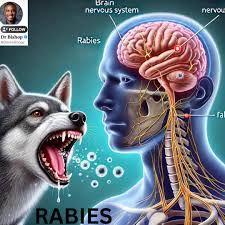Meaning of Rabies
Rabies is a viral disease caused by the rabies virus, which is part of the Lyssavirus genus. It primarily affects mammals and is transmitted through the saliva of infected animals, usually via bites. Rabies leads to severe neurological symptoms and is almost always fatal once clinical symptoms appear. The disease is preventable through vaccination and timely medical intervention after exposure.

Animals that can pass Rabies
Rabies is primarily transmitted by wild animals, but domesticated pets can also carry the virus. Common carriers include bats, raccoons, skunks, foxes, and coyotes. Domestic animals such as dogs and cats are significant sources of rabies transmission, especially in areas where vaccination rates are low. Any mammal can potentially harbor the virus; however, rabies is most prevalent in carnivorous and omnivorous species.

Signs and Symptoms of Rabies
The incubation period for rabies varies, typically lasting from one to three months, but it can range from weeks to years. Initial symptoms may resemble those of the flu, including fever, headache, and general malaise. As the disease progresses, more severe symptoms develop, such as anxiety, confusion, agitation, hallucinations, difficulty swallowing, and hydrophobia (fear of water). Eventually, the patient may experience paralysis and coma, leading to death due to respiratory failure.

Effects of Rabies on the Body
The effects of rabies are devastating, both for the individual affected and the community. The disease causes acute encephalitis, which leads to irreversible brain damage and death. In areas where rabies is endemic, human fatalities can occur due to lack of access to vaccines and post-exposure prophylaxis. Furthermore, rabies poses a significant burden on public health systems due to the need for vaccination programs for pets and wildlife.

Prevention of Rabies
Preventing rabies involves several strategies. Vaccination of domestic pets and livestock is crucial in controlling the spread of the virus. Public awareness campaigns educate communities about avoiding contact with wild animals and the importance of seeking medical attention after potential exposure. Controlling stray animal populations can reduce the risk of rabies transmission.

Treatment of Rabies
Once clinical symptoms of rabies appear, there is no effective treatment, and the disease is nearly always fatal. However, rabies is preventable if treated promptly. Post-exposure prophylaxis (PEP), which includes a series of rabies vaccinations and rabies immune globulin (RIG), is effective if administered within a few hours to days following exposure to the virus. Prompt medical attention is essential for anyone bitten by an animal suspected to have rabies



